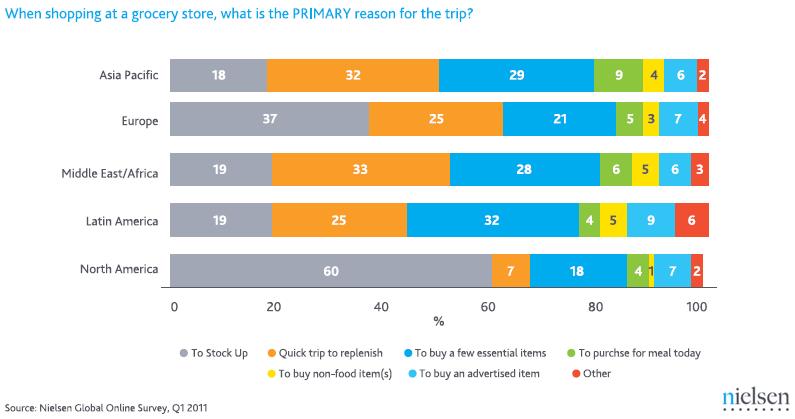It turns out that they also approach the whole concept of grocery shopping with a very different mindset.
Some of this has to do with Americans' notorious focus on making money, another feature which differentiates them. Buying, preparing and eating food is more a means than an end, though this is changing somewhat. Another contributing factor is car culture: Americans want convenience, so they drive whenever possible, meaning that they can buy bigger loads with their greater incomes.
And Americans tend to have bigger homes with greater access to reliable and relatively inexpensive refrigeration, meaning they can store more stuff so that the shopping experience can be more about replenishment than immediate requirements.
But ultimately, it may just be that Americans buy more because they can. And because they feel like it, even in the face of a declining household incomes and a stagnant economy. Which is probably the greatest difference of all. JL
Priceconomics reports:
Americans play football with their hands and measure height in feet and inches. Now we can add to the list of ways in which we are outliers: Americans shop for groceries differently from the rest of the world.Source: Nielsen Newswire (2011)The above chart comes courtesy of the market research firm Nielsen. As we see, Americans' (actually North Americans') grocery buying habits stand out. While most of the world tends to make regular trips to shops and grocery stores to grab a few items, North Americans' typical grocery trip ends with a car full of groceries to feed a family for a week. The report attributes this to high gas prices and the prevalence of "hypermarkets" like Walmart and Stop & Shop, which incentivize people to make a few strategic trips, as well as the availability of storage and refrigerator space in American households.Europeans also stock up and make fewer trips, but less so than in North America. Europe has high gas prices and one stop shops like Carrefour, but it remains common to make multiple trips - one day to the grocery store, another day to the baker, and yet again to the butcher.People in Asia, the Middle East, Africa and Latin America are much more likely to shop daily for their immediate needs, rather than stockpiling groceries at home. (This won't surprise those used to the street food scene of many countries, in Asia in particular.) Nielsen credits the difference in grocery buying behavior to "the structure of trade, household size and refrigeration availability around the world."Nielsen's report is available here.





















0 comments:
Post a Comment